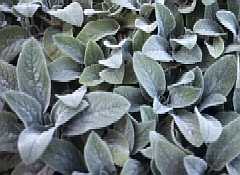|
What I
do
Seed Starting
The Vegetable Garden
The Flower Garden |
|
STACHYS (Lamb's Ear) Stachys
byzantina, "Helene Von Stein"  w many of us as children remember touching
the fuzzy leaves of a plant described as Lamb's Ear? I do, except
that my mother had called it "Rabbit's Ear," and I suppose
that was more appropriate, since we saw more rabbits than lambs in our
suburban back yard. w many of us as children remember touching
the fuzzy leaves of a plant described as Lamb's Ear? I do, except
that my mother had called it "Rabbit's Ear," and I suppose
that was more appropriate, since we saw more rabbits than lambs in our
suburban back yard.
There are several cultivars of Stachys (pronounced STAY-kis), and all grow in full sun. They can take drought, but are prone to rot if grown in a poorly drained location. They are wonderful in borders, forming dense mats of silvery-gray foliage that compliment the colors of any nearby plants. It is perennial, and very hardy here in Missouri. Cultivars Another variety that I am growing this year is Stachys coccinea. What a wonderful plant! This is one variety that you will want to see in flower. Small flowers appear on a spike in the center of the plant, and are light red in color. It is absolutely lovely, and surprisingly little known. I found Stachys coccinea harder to obtain locally, so I grew it from seed, and it bloomed in its first year. Maintenance |